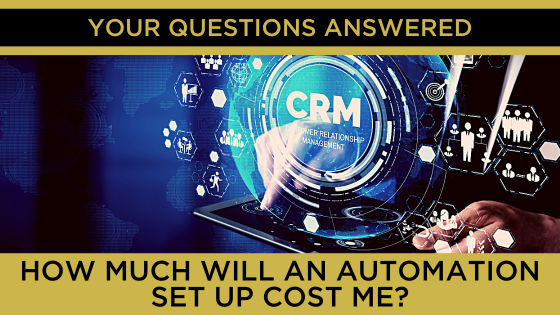How much will an automation set up cost me?
Any busy business owner knows that one of the best ways you can give your business a leg-up and set it up to grow is to take all those tasks you do over and over again, and automate them. Anything from having a reminder to follow up on calls you’ve had, to sending regular emails can really take the pressure off you, while giving your customer a great experience.
What’s more, there are a wealth of tools and systems that make automation easy. Applications like Zapier will connect one piece of software to another (so, for example, when someone books an appointment via Calendly, it can add them to your CRM system as a contact) others, like Capsule, can help you track where a prospect is in your sales pipeline and create tasks for you at each stage, while still more tools such as Keap, will create elegant workflows so you are able to map out a process and add emails, tasks, campaign steps and more, making everything flow smoothly.
Sounds wonderful, doesn’t it?
And it is – but if you’ve ever decided to set up automations, you’ll have spotted the gap in the idea. Automation tools all take time and know-how to get them working in a way that gives you what you want and need. So maybe it would be better to get someone else to set it all up for you. If that’s the case, what might you expect to pay?
Scope of the process
With any automation, the biggest cost factor will be down to what you want an automation to do. Many, of course, are very simple “When a customer signs up, send a welcome email,” for example and you can do them yourself. But they get more complex quite quickly: “When a customer signs up, send a welcome email, set them up on the accounting system, give them access to the online content and notify the admin team to create the customer files in our support system.” That’s quite a lot of different steps and may involve several systems.
So, scoping is essential and takes thinking time.
A few questions to ask yourself before you begin:
- Who is your audience for this automation? Is it prospects? New clients? Past clients? Members of your team?
- What is the outcome you want? A good follow up, so more prospects become clients? A great onboarding experience? More repeat business? A better relationship with your staff?
- What starts your automation or makes a change in a workflow? Is it when a customer makes a purchase? Or when a piece of work finishes? Or is it at a point in time?
- What is the audience journey to reach that outcome? What needs to happen, by whom and and when?
- What are the components you need to achieve that journey? Do you need to send emails, set tasks to team members, show a video or ask the audience to fill in a form?
- Which systems do you use for each of the components and what data needs to move between them? Is the current package you have sufficient to allow for automation?
Scoping is essential to give you the right result. If you already have documented processes, it is a lot easier because a lot of thinking is already done, but the more planning you do up front, the better the result and the less time it will take to build the automation and the less problems you’ll hit along the way.
The scoping can take anything from a couple of hours to a couple of days to complete, depending on how complex the automation.
One tip at this point: if you have lots to automate, do some high-level scoping for everything up front, then go into detail for one element, build that, get it working and then do the next one.
Why? Because you will hit unforeseen issues when you build that first flow – you might find a package you use needs an upgrade or doesn’t do what you expected. You can then take a view on whether to upgrade, develop a workaround or switch to another tool that better meets your needs.
Time for each type of automation step
An automation then breaks into a number of components:
- Setup – if you are investing in a new tool for any part of your automation, you will need to set up your new system. You’ll need template pages or emails with your branding, for example, and you’ll want to be sure all the data is in place. This takes around 4 hours to get done for each system.
- Integrations – moving data from one system to another. For example, you might have an online course and, when someone buys, you want to add that contact to a mailing list. Or perhaps you want to add customer details automatically to your accounting software. For each integration (each move of data) you need to allow an hour for building and testing.
- Content – for most of the components of the automation, such as emails and landing pages, you need words to get your message across. Task to members of the team also need to be clear, so they know exactly what is being asked of them. You need to allow between 2 and 3 hours per 500 words for polished content.
- Workflows – a workflow manages each part of the automation, using triggers to decide when to move to the next step (wait 4 days, then send the next email, for example). To build and test a workflow of 4 steps takes about an hour, including adding the content to emails and creating landing pages.
- Branches – sometimes you want the same automation with different data. Suppose you offer three price points for your package, with different features in each. You’ll use the same customer onboarding automation but the emails relating to features need to be different. That actually means having duplicate workflows, with different versions of the emails in each version. Once the workflow is set up, you need to allow an hour for each extra branch you build.
- Documentation – it is very tempting to skip this step, but we really don’t recommend it. Keep records of what you have done, what goes where, decisions you made and, if other people need to use or maintain the system, create a user guide and a technical guide. Allow 4 hours for this – but don’t leave it to the end of the automation setup. Make notes as you go, it makes the task much less of a burden.
With the scoping done, you can now add up the time needed and multiply it by the hourly rate, to give yourself a cost.
Fixed price
In reading the above, you will have realised that there is a lot involved in getting automations working and, while they can make your life easier, you do need to invest – either in your time or someone else’s to get them working.
If your budget is limited, spend it on help with the scoping – an expert will help you make good decisions and plan a flow that will work for you, so you can then get on and build it. They will also know which tools talk to one another, the upgrades you might need and have ideas for ways to get integrations and workflows working well.
At Creative Words, we love setting up automations – from planning them out, to writing the content, to building and testing everything. We can work with most of the main integration, marketing and CRM tools and, if you work with us, we give you a fixed price calculated from the scope, so there are no surprises in what it will cost. You can even spread the cost across several months, to make it easier for you to go ahead.
Interested? Get in touch to have an initial conversation about how automations can make your life easier.












Leave a Reply
Want to join the discussion?Feel free to contribute!